Last Tuesday I posted the start of my first game of Blucher, the Napoleonic rules from Sam Mustafa. I had gotten as far as the initial setup, which is shown here in the first photo. Two equal forces of 200 points, French on the left, Austrian on the right. Both armies are organized into three corps each, two of infantry (four brigades plus an artillery unit) and one of cavalry (two light and two heavy brigades plus a horse artillery unit). Both sides have one commander and one sub-commander. The Austrians have to hold the road towards their table edge, plus the hill on the top of the picture. The Austrians have one quality corps of four grenadier brigades (I Korps on the road) and one of two line brigades and two Grenz conscript brigades (II Korps on the hill).
Both forces were generated from the Army Builder lists in the Blucher rulebook. I could have created an historical battle but will save that for another day when I have more time for research.
I used the standard game clock of 30 turns. Blucher is played in alternating turns, so each side gets 15 turns to achieve its goals.
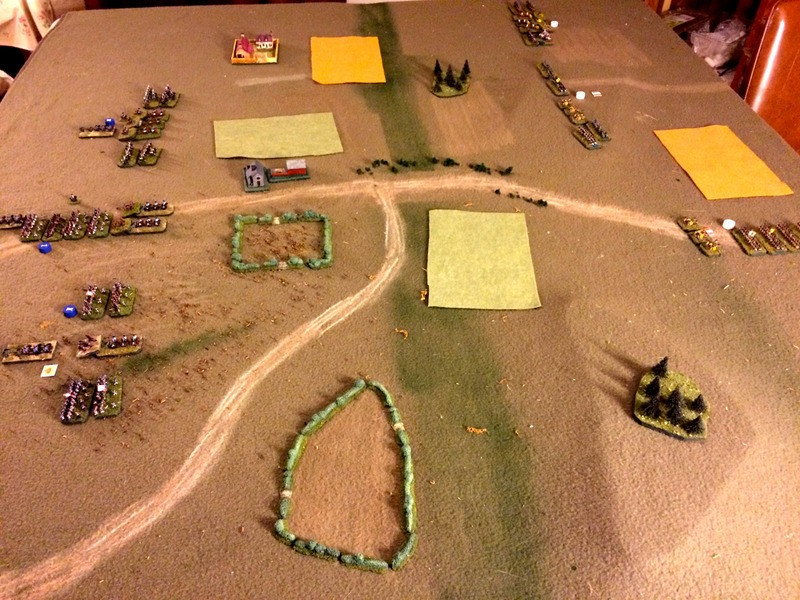
And we’re off. The French i Corps in the centre gets most of the initiatives for the first turn and marches at the Austrian centre. What I quickly discovered is that even with a relatively small force, it’s hard to achieve your goals each turn. Blucher uses a system of Momentums or MOs, which are generated by rolling 3d6 to generate the number of MOs a side gets per turn. In a two player game, the passive player rolls the dice and keeps the total number of MOs secret from the active player. The active player has to decide first which units in his Corps he will move (it costs one MO per unit in a Corps that wishes to move or fire), then decides if he will move or fire any units not part of a Corps (2 MOs per unit), then which units he will activate with his Army Commander, something you would only want to do if you had units from several Corps that were intermixed and you wanted to be sure of moving them in a single turn. The problem for the active player is that he doesn’t know how many MOs he has at the start of a turn. The passive player keeps track of the MOs being spent and then informs the active player when he’s done, which might come as a shock. This means that in a two player game the phasing player can never be sure if he has enough MOs to achieve his goals for a turn, which could be quite suspenseful.
For a solitaire game, the problem is figuring out how to achieve a similar effect. After a few turns of just rolling all the dice and the portioning out the total to my units as I wanted, I decided I was going to allocate dice to corps before rolling them. For independent units (the French had one independent artillery unit) I would allocate the pips to that unit from whatever the total rolled would be. This way, if I rolled a dice and had more pips than a corps needed, too bad, they were wasted for the rest of the army. If I had less pips than the corps needed, also too bad. If I wanted to be sure a corps got to act, I allocated it two dice knowing that that would sacrifice the actions of the other corps for that turn.
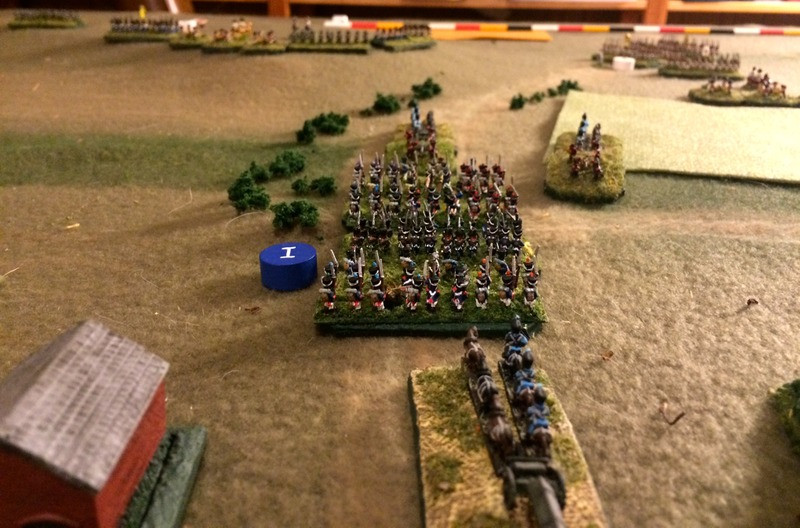
General Kurvi-Tasch watches from the II Korps position in the Austrian centre on the Plotzen Heights. At this point I realized that I was using a table 6 foot wide by 5 foot deep, with 6mm figures. Given that an infantry move using my base width system was 60mm a turn, that would take a long time to get into contact. I decided that I would adapt the Blucher rule for Reserve Moves, which allows units that begin while Concealed to move 12 BW, provided that they do not come within 4BW or are observed by an enemy unit. I decided I would borrow from other rules that allow for some sot of enhanced grand tactical move provided that they do not come within range of the enemy. I allowed all units to use Reserve Movement provided that they did not come within artillery range (8 BWs) of the enemy. Once units came within 8BWs of the enemy, they had to stop and used normal movement from then on.

Guns of 1 Korps on the Austrian left open fire. Here I quickly discovered that counter battery fire in Blucher is a vain hope. The number of dice artillery get to fire depends on their ammo level. Most artillery units (which are the same as grand batteries) start with 5 dice, then get two turns of 4 dice, then 1 of 3 dice, then 2 of 2 dice, at which point they are out of ammo and leave the table. Artillery dice are halved firing against other artillery. As with all fire combat, only sixes hit, though heavy artillery get to count one 5 as a hit. It takes two hits to drive an artillery unit off the table, while only one hit forces artillery to retreat. Here the 1 Korps guns waste their best dice shooting at the advancing French artillery, while the grenadier brigades deploy behind the guns.
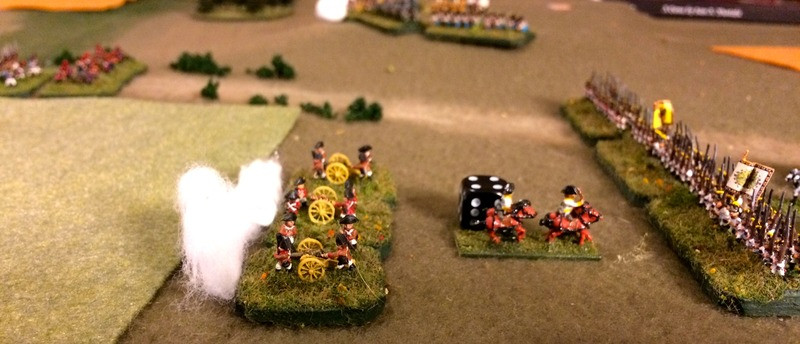
I Korps guns score a hit on the advancing French infantry of 1 Corps. I used blue micro dice to indicate hits on infantry and cavalry units. As Mustafa writes in the rules, casualties in Blucher are attritional. Units are rated by élan, ranging from a starting score of 7 (elite) to 5 (conscript). Once a unit falls to 0 élan, it breaks and is removed from the table. Broken units count towards an army’s demoralization level, which is one third of the starting total of cavalry and artillery units.
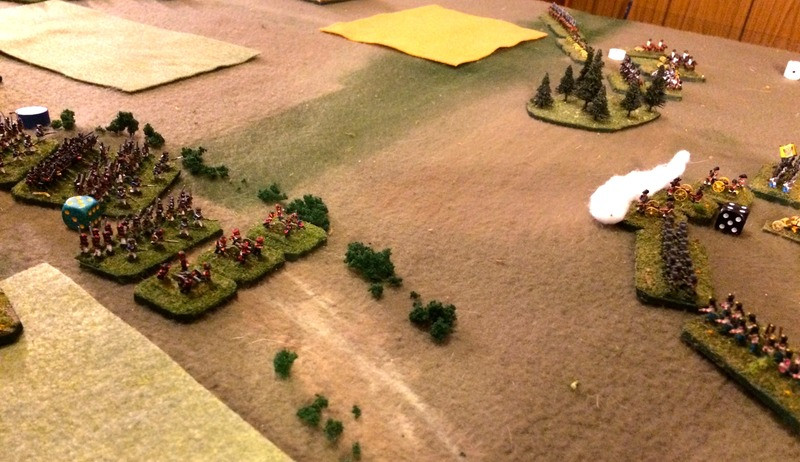
The situation at midmorning. The French have had some very poor MO roles, so the 1 Corps attack on the centre has not really advanced. The two cavalry corps face each other at the top of the picture. By leaving the southern hill of the Plotzen heights unoccupied, the Austrians may have given the French an opportunity.
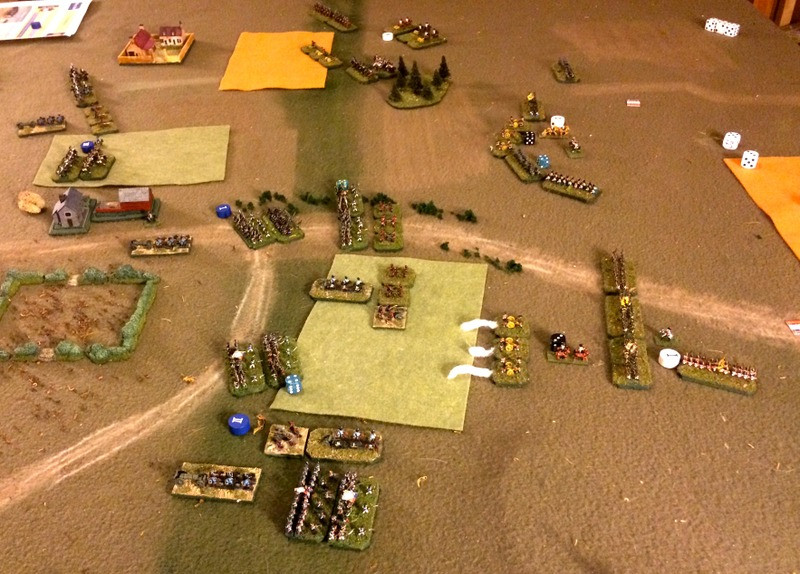
By noon the French attack is developing. All four French artillery units fire in the same turn. Two of the Austrian brigades holding the Plotzen Heights have been battered by artillery, and withdraw behind the crest The French have gotten I Corp’s artillery onto the southern hill, before the Austrian grenadiers can get there, and fire a blast of canister into the oncoming Kaiserlichs. Meanwhile, the Austrian cuirassiers advance and take some damage from the French horse artillery as they do.
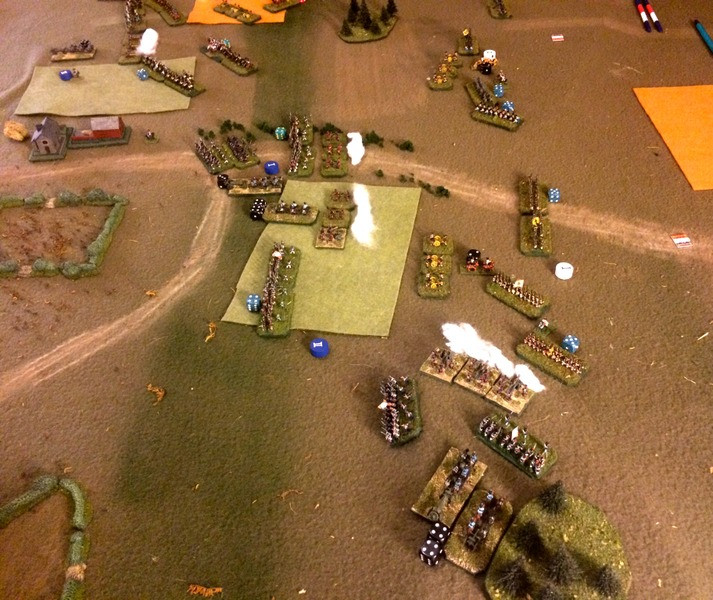
Ouch. Poor grenadiers have fallen to five élan and haven’t even gotten to the top of the hill.

The grenadiers press forward for the melee combat. Melee, like fire combat, depends on the élan level of the attacking and defending units, which determine how many dice they get to roll. Since artillery units don’t have élan, their dice in combat depends on their ammo level. Here the 1 Corps artillery has ammo level four, so they will get 4 dice in the coming melee.

A bad outcome for the Kaiserlichs. Normally the Austrians would get an extra dice for being a shock unit as grenadiers, but since they are attacking uphill they lose a dice. The result is a tie, which means they lose and will have to retreat. All attacking units, win or lose, drop an élan level because they have attacked. Defending artillery in melee combat lose an ammo level.

Another example of melee combat in the developing cavalry duel. The Austrian hussars are rated as elite (7 dice) against the French hussars’ six, but the Austrian roll isn’t that great (only 4s, 5s and 6s count in melee combat). Both sides lose en élan level (defenders lose élan levels equal to the difference between the attacker’s and defender’s score).

Cavalry battle develops. It hasn’t gone well for the two brigades of Austrian cuirassiers, one of which (bottom left of photo) is down to 2 élan and is retreating in the hopes of retiring from the battle. In Blucher units can be retired voluntarily from the table if they are more than 2 BWs from an enemy unit, which means that depleted troops can be removed from play before they break and count against your demoralization total. The downside is that you lose if you have more voluntarily retired units than you have units left in play. I hope you all go oohhh and errr at that incredibly sexy measuring stick in the top left of the photo!

In Blucher horse artillery has the mobile quality, which means it can move and fire in the same turn at the cost of two MOs, Horse artillery units can be quite lethal if protected, which doesn’t always happen if there aren’t sufficient MOs. Here a depleted French dragoon unit (centre) charges the Austrian horse artillery, which loses the fight and is broken. Meanwhile the French horse artillery torments the Austrian hussars. At the bottom right I’ve used one of my cassion stands with a black micro dice to indicate the ammo level of the French guns.

In the last few turns of the game night is falling and the Austrian cavalry have been swept from the table. On the Austrian left, the proud grenadiers of 1 Korps still stand firm. One of their four brigades has been broken, but they still protect one of the two objective markers that the French need for victory. Here two French brigades charge into a full strength Austrian grenadier brigade. The French get ten combat dice, while the Austrians get seven, plus one for the Steady trait of grenadiers plus one for the Steadfast quality of the 1 Korps sub commander, General Brodzky. In the final combat of the game, the Austrians have rolled four scoring dice against the French three, forcing the two French units to retreat. With night falling fast, the grenadiers have successfully blocked the road to Szhod. Brodzky is wounded in the battle, but he will survive and be handsomely decorated.
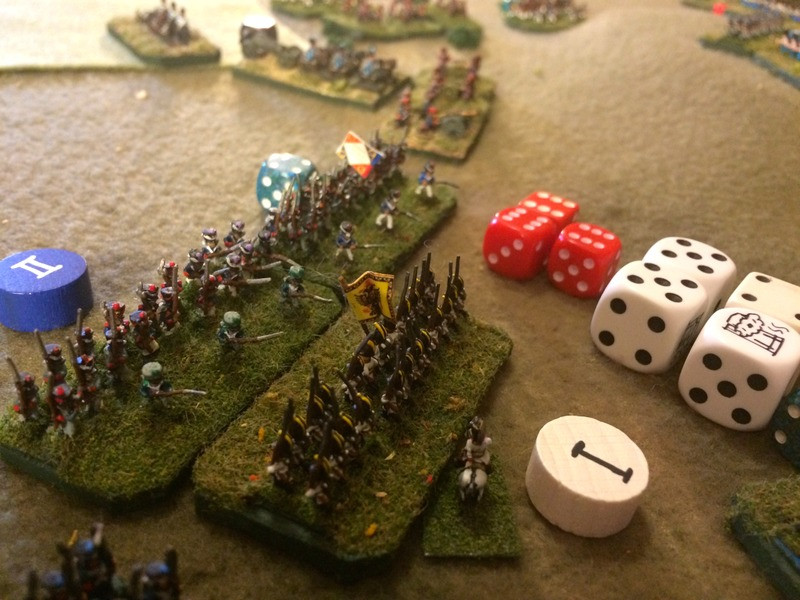
A view of the final positions at the end of the game. The Austrians have three broken units, one short of the four required to demoralize them, while the French have only one broken unit. However, the Austrians hold both the French objective markers, so it looks like an Austrian victory. While the cavalry duel was won by the French, it cost them valuable MOs that could have better been spent assailing the Austrian centre, where the Austrian infantry was weakest, so the sacrifice of the Kaiserlich horse was not in vain. General Turandotte will have to explain to the Emperor why he has not broken the Austrians and opened the road to Szhod.
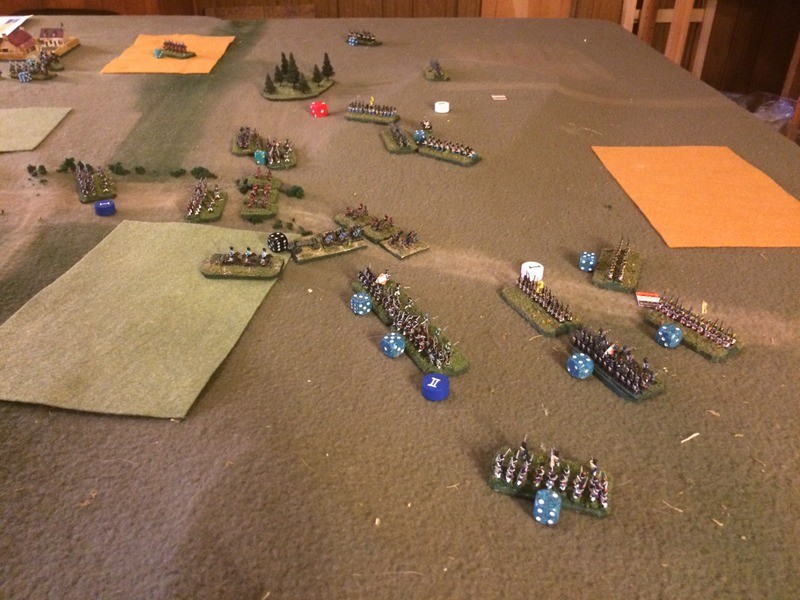
In conclusion, I have to say that I am a fan of Blucher. Some might prefer a more detailed, granular game. For example, there are no morale tests for receiving fire or for being charged, and the command and control rules are almost entirely abstracted into the system of MO dice. Other than having useful qualities which might bring sub commanders and commanders into combats (the French cavalry sub commander brought an extra dice to each melee he was in, and miraculously he was never killed or wounded), there is no point in having leader figures on the table. However, as with Longstreet, the other Sam Mustafa rules system I’ve discussed on my blog, some might say that this abstraction gains a high level of playability. Once I got the hang of the basic systems the game moved quickly. I think with another game of this size, i could get through it in 3-5 hours, which is doable for evening with friends or at a club.
Also, as you can see from the last photo, there are some bookkeeping issues I need to resolve. I’m not happy about the micro dice cluttering the table to indicate élan and ammo levels. This bookkeeping could be moved to paper, but then I would need labels or tags to identify individual units, which I suppose could be developed and printed and then just tucked underneath the units, or glued to the back base edge, but I am loath to permanently assign unit identities to my stands - I would rather keep them generic for different battles and OOBs. I would welcome your ideas.
There are some advanced rules with Blucher I haven’t tried yet, and as I said above, the dynamic of the MO dice in a two player game would be a whole different level of suspense and challenge. However, I’m quite favourably impressed with my first look at Blucher and I’m sure I’ll have more adventures with these rules to describe here in future. I think the next set of rules I try for this period will the Polemos General de Division rules from Baccus, once I clear the table and try something else for a palate cleanser.
In the meantime, mes brave soldats, blessings to your die rolls!
MP+

This comment has been removed by the author.
ReplyDeleteTony, where did your comment go? I was about to answer it! :(
DeleteLooks good Mike and I'm delighted to see you getting a game in. Simple rules are best in my experience and far better a set of simple rules that you actually get to play, when a complex set that you do not.
ReplyDeleteHave you considered casualty markers for Elan?
Thank you kindly CK. I hadn't considered casualty markers, I could give that some thought. Baccus just released some French casualty figures - I suppose I could base some with numbers in various denominations, though I think a simpler solution, as KK suggests below, is to BluTak some quick labels onto the bases to differentiate the units and then record Elan on a paper roster. It does bear pondering, however.
Delete"For a solitaire game, the problem is figuring out how to achieve a similar effect."
ReplyDeleteIt's easy. Make a move, and note down how many MOs it cost. Roll 3D6. If the score is less than or equal to this total, your turn ends. Otherwise make another move, keeping an accumulated total of MOs, and roll 3D6 again. Again, if the score is equal to or less than your total, end the turn, otherwise move again ...
Each roll represents your opponent checking the MOs you have expended against the number you rolled, basically.
KK - I think I understand. One would have to roll the 3D6 after every move, comparing the number to a growing total, and while that's a bit of work, it's not a bad idea. What if the die roll is less than the total for the last move? Would that last move be allowed to standt or would it not count? How does your group play it?
DeleteMichael - Unlike most PIP systems, in Blucher an individual move can exceed the PIPs. You just can't make one afterwards.
DeleteSo, in a two-player game, your opponent rolls 6 MOs for you. Your first move costs 4MOs, so your opponent tells you you are good to make a second move. Your second move costs 6MOs. You make your move, and *now* your opponent says 'Stop'. You rolled 6MOs, but actually expended 10. But that's legal.
Basically you only need 1 MO in hand to make a move, regardless of how many MOs that move will cost.
Intuitive generals (see commander abilities) get to roll and see their own MO score - quite a useful ability.
Thanks KK, that's a helpful clarification.
DeleteI hadn't read the Intuitive quality in the leaders section, I had only looked at the SubCommanders' traits. That could be a very helpful ability.
"but I am loath to permanently assign unit identities to my stands - I would rather keep them generic for different battles and OOBs. I would welcome your ideas."
ReplyDeleteI use Blu Tak.
I note you used your artillery in batteries. We rarely do this in our games; the option of doling out guns to individual units to give them a +1 dice when firing is far too tempting.
BluTak (nods wisely).
ReplyDeleteAS for the artillery units/batteries rather than integrating the artillery into individual units, I had thought about that. I guess I have all these artillery and limber figures and wanted to use them, plus I was hoping for more from massed artillery. I can see some downsides to artillery units - they consume MOs, they take up space, require ammo tracking and become less effective as the game goes on. Plus, another downside is that artillery broken in combat count towards an army's break total. I shall try integrating artillery into units next time - a 7 élan grenadier unit with an integrated battery would be a fearsome thing!
Take Two - I put in a home-brewed tweak to get around the solo MO difficulty, then subsequently realised that the tweak as i described it doesn't actually make sense for Blücher as it stands - I described an evolution of it for use elsewhere. Thus I have scrapped my note, on the grounds that it was bollocks, and I write enough bollocks at the best of times. The rest of what I said was:
ReplyDeleteI am especially interested in this - I have the book, I've read it and been impressed (at a theoretical level) and done a lot of head nodding (yes, that makes sense, etc) but was very much aware once I'd finished that I was in nothing like a proper position to try a game, so I have been building up to Read Two, which requires extra coffee, notepad and paper etc. Thus I am very pleased to see reports on an actual game by someone other than the originator! It looks good, I have to say.
I am a little inhibited by the certain knowledge that i am going to try to tweak the game before I try it - one area which I did some thinking about was exactly the solitaire MO issue which you have highlighted - I believe we exchanged some thoughts on this at the time.
Anyway - I am feeling guilty about not having made more progress with Blücher myself - I am very pleased with my vicarious involvement in your greater level of success - excellent! Looks like a good game, and the lack of granularity and the reduced number of morale rolls are, as you say, correct for the size of action the rules are aimed at.
Great! - cheers - Tony
Ah, there you are, Tony. I thought you had ducked out to go behind the cricket pavilion for a smoke. In general I like the way Sam writes his rulebooks - they are a far cry from the densely packed text of the WRG era.
DeleteThe Blucher forum on the HONOUR website is also a useful resource for subjects like MOs in solitaire games: http://www.sammustafa.com/honour-forums/
Interesting exercise first time up. Having recently played my first ever Sam Mustafa game (Lasalle) I could follow some of your game, recognising some of the conventions in common.
ReplyDeleteI admit to a marked preference for having the figures carry the information, hence the casualty removal and smoke markers. But keeping track of what has or has not moved, when this is critical, is less easy to monitor in tidy fashion. ^mm scale warfare also doesn't lend itself easily to casualty removal neither!
I know of one blogster who uses small stones to indicate the status of a unit. This has the virtue at least of looking like casual rocks dotting the battlefield. Personally, I have a distaste for casualty and wrecked markers, which seem to be a feature of rule sets I would otherwise like (such as Age of Eagles/Fire and Fury).
Having said that, speed of play, overall playability and a sufficiency of 'realism' answer for a lot of trivial niggles...
Thanks Ion. I don't especially like cluttered tables either, though I have a morbid fascination with casualty markers to remind me that what I am portraying on the table is not the parish strawberry social - it's easy to forget that.
DeleteI have the Naps rules you sent me last year printed, and was thinking I'd give them a try seeing as I have some time on my hands. MTF.
Thanks for this write up. I hope to get into Blucher after Waterloo. I liked KK's suggestion re solitaire MO.
ReplyDeleteI'm with you re labels and clutter. I'm struggling with it for my Waterloo game, especially as I find I need to use "large print", but it is essential with players who don't know the troops and also nice to be able to name the unit as you throw it into combat.
My other comment is to note as you did the importance of getting the table size right for the base width movement. In the one game I have had so far (I was umpire) one side did a bold flank attack through a forest, but failed to calculate how long it would take.
KK is a clever chap.
DeleteIf I was playing a Waterloo game, I'd want to know which figures were the Old Guard, the Union Brigade, etc. I don't mind a generic feel for a points game, but for an historical scenario, I'd want cards or labels or something.
For a situation like you described where one side wants to make a flank march, you might allow the use of the Reserve Move (Blucher p. 39) until the moving units come within 8BW of an enemy unit?
Interesting, will follow your experiances with the rules
ReplyDeleteIan
Michael, your 6mm armies look fantastic and your excellent Blucher play-through really is helpful for those yet to try the rules.
ReplyDeleteHrm.... Think I like the way you described Longstreet's gameplay better. Still though, the table with so many beautiful units looks amazing Mike.
ReplyDelete